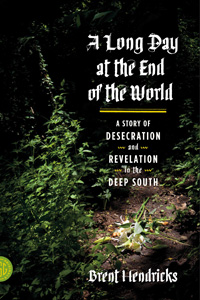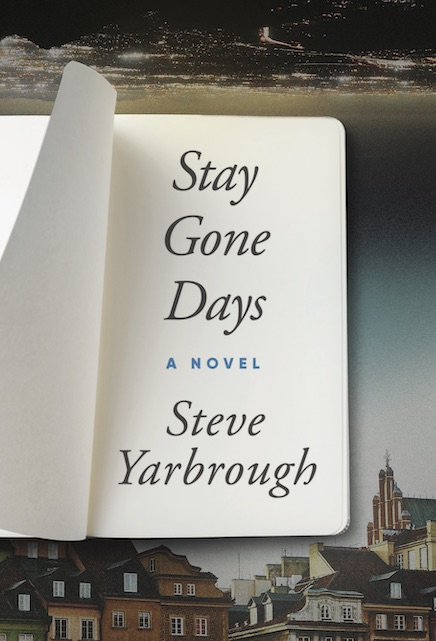Troubled Bones
In a Southern Gothic memoir, Brent Hendricks writes of his pilgrimage to the Tri-State Crematory
I was setting off to unholy ground, to a field with a lake where hundreds of bodies once lay scattered and alone, hoping that something would happen. For a while I’d lived with an image of my father lying lost at the Tri-State Crematory, and I needed to change it. I needed to take a ride to Tri-State and see where he’d lain all those long years. I needed to tell him goodbye, or hello and goodbye, or tell him nothing but that I had tried. I had tried to make amends for his troubled bones.
 In his debut memoir, A Long Day at the End of the World: A Story of Desecration and Revelation in the Deep South, poet Brent Hendricks writes about the “largest mass desecration in modern American history” and of learning in 2002 that his own father’s corpse lay among hundreds of bodies that had been discarded outside at the Tri-State Crematory in rural Noble, Georgia, just south of Chattanooga. With Southern Gothic elements, this slim book is structured around Hendricks’s pilgrimage to his father’s makeshift gravesite on the sprawling grounds of the crematory.
In his debut memoir, A Long Day at the End of the World: A Story of Desecration and Revelation in the Deep South, poet Brent Hendricks writes about the “largest mass desecration in modern American history” and of learning in 2002 that his own father’s corpse lay among hundreds of bodies that had been discarded outside at the Tri-State Crematory in rural Noble, Georgia, just south of Chattanooga. With Southern Gothic elements, this slim book is structured around Hendricks’s pilgrimage to his father’s makeshift gravesite on the sprawling grounds of the crematory.
The initial investigation had been triggered when a dog walker stumbled over a human skull; aghast, emergency workers eventually found 339 decomposing bodies, some barely concealed. In spite of having a functional crematorium, Tri-State Crematory manager Brent Marsh had distributed them across the wooded property, in storage sheds, metal vaults, and amidst foliage. The majority he discarded in eight burial pits that he covered with soil, garbage, and, in one case, an old pool table. Marsh, a former football player for the University of Tennessee in Chattanooga, had taken over the business following his own father’s stroke. A husband and father himself, he lived a seemingly exemplary life, coaching football and basketball teams, volunteering as a church deacon, and serving on the board of the local chapter of Family and Children’s Services. To this day, he has never offered any explanation for his actions.
In lieu of human ashes, he gave burned wood chips, dust, and squirrel skeletons to the family members of the deceased whose bodies he left to decay outside. While the identities of more than a hundred bodies discovered at Tri-State Crematory are still unknown, Hendricks’s father was identified because he’d been buried twelve years earlier in custom-made cowboy boots bearing his name in one heel.
 Ron Hendricks had died in 1990, at fifty-nine, and he was laid to rest in one of two adjoining burial plots purchased by Hendricks’s mother. In 1997, however, she decided she couldn’t bear the thought of “sleeping with worms,” and she had Hendricks’s father exhumed and cremated. Feeling less alone, she talked to the box bearing what she believed were his ashes as if he were still alive. Five years later, when it was confirmed that these contents were almost entirely made of cement dust, she, along with her grown children, felt betrayed and unmoored.
Ron Hendricks had died in 1990, at fifty-nine, and he was laid to rest in one of two adjoining burial plots purchased by Hendricks’s mother. In 1997, however, she decided she couldn’t bear the thought of “sleeping with worms,” and she had Hendricks’s father exhumed and cremated. Feeling less alone, she talked to the box bearing what she believed were his ashes as if he were still alive. Five years later, when it was confirmed that these contents were almost entirely made of cement dust, she, along with her grown children, felt betrayed and unmoored.
Like a reporter, Hendricks delves for an explanation for Marsh’s behavior but comes up empty-handed. He rules out a psychologist’s theory that Marsh was a hoarder, arguing that the crematory manager had “acted with premeditation in his meticulous development and deployment of fake cremains, and, quite clearly and inexcusably, he exhibited a real cold-bloodedness in his disregard of hundreds of bodies.” Marsh pled guilty to theft, fraud, and abuse of a dead body, and was sentenced to twelve years in prison.
When the cover-up at Tri-State made national news in 2002, Hendricks and his wife, Kate Bernheimer, were living in Portland, Oregon, as “middle-aged hipsters, literary types,” but in 2005, Bernheimer accepted a teaching position in the creative-writing program at the University of Alabama. The couple moved to Tuscaloosa, the location from which Hendricks embarked on his pilgrimage to the Tri-State Crematory. In A Long Day at the End of the World he interweaves details about this trip with the story of Spanish explorer Hernando de Soto, who “trooped through Georgia and Alabama in 1540, searching for gold,” a quest Hendricks compares to his own search for peace. Just as de Soto’s “gaze remained fixed on an absent thing—his dazzling piles of gold,” he writes, “I remained focused on the lost body of my father.”
The parallels Hendricks draws between his journey and that of de Soto reappear throughout the book; both hinge on ill-fated discoveries and each man’s maniacal drive to arrive at a predetermined ending. While the transitions from Hendricks’s own travels to his ruminations on the varieties of racism, violence, and greed across Southern history are sometimes abrupt, they do resonate with vivid, haunting imagery. Ultimately, the trip to Georgia represents far more than a man’s final farewell to a father whom he remembers with resentment and remorse. This dark, belated endeavor illuminates the struggle to right a wrong that can’t be undone. With no choice, Hendricks walks through this personal apocalypse and comes out on a different side: shaken and alive.
Brent Hendricks will appear at the twenty-fifth annual Southern Festival of Books, held in Nashville October 11-13, 2013. All festival events are free and open to the public.


